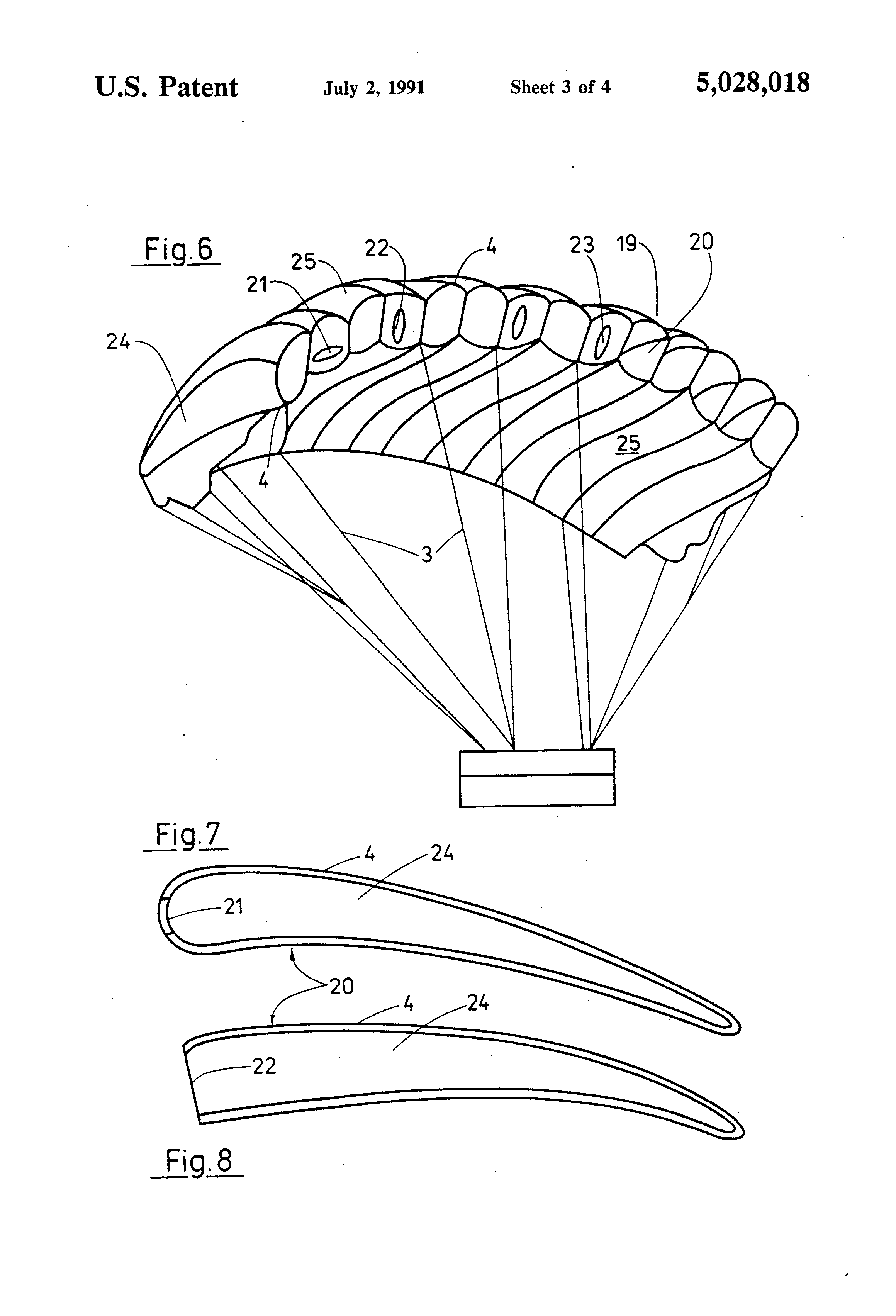I was jumping an Icarus Crossfire 2 149 over the weekend.
The Crossfire 2 is a fully-elliptical, non-crossbraced nine-cell main canopy. This puts it in the same class as the Katana I demoed a few weeks ago, both of which are considered higher performance than my current semi-elliptical Sabre2 main.
Deployment
The Crossfire 2 seems very well-behaved during deployment. It sometimes inflated unevenly in a way that causes a turn, but even then it was controllable with harness input and it generally stayed within 90º of the original heading. This is in stark contrast to my experiences on a Katana, which seemed to strongly prefer opening in random directions.
One thing that's new for me is the fully-formed nose on the Crossfire. In other words, the Crossfire wing has a leading edge that happens to have holes in it, whereas the other parachutes I've used have holes instead of a leading edge. An unrelated patent filing has a useful diagram; compare figure 7 to figure 8:

This design seems to work quite well in practice, especially on deployment:

I found Crossfire 2 inflations to be very reliable, having experienced no end cell closure or slider-up conditions to date. This is quite unlike both the Sabre2 and Katana.
Evasion
Sometimes it's necessary to perform evasive maneuvers immediately after deployment. In this situation, the canopy's brakes are still stowed, leaving rear risers, front risers, or harness input as the remaining controls to steer the canopy.
Rear risers are the usual choice, and the Crossfire 2 turns as expected.

Harness input is too slow to be useful here, also as expected. Front risers were a surprise for me: small inputs did nothing, while large inputs seemed to induce a front riser stall. Neither were useful for changing headings.

So, whereas my Sabre2 gives me the option of turning flat (rears) or turning in a dive (fronts) to avoid traffic right after opening, the Crossfire 2 does not. Good to know.
Flight controls
The toggles are everything I wanted them to be: very effective at reducing airspeed, easy to whip the canopy around on command, etc. That said, the brakes lines seem quite long – there's about four inches before I get any tail deflection – and it's my understanding that Icarus prefers them that way.
There seems to be plenty of flare power at regular airspeeds, but given all the wind we had this weekend, I haven't needed to use it yet.
The rear risers are heavier than I'm used to, though they have a good feel. The demo risers are hard to grip with my winter gloves, so most of my sustained rear riser flight was with a finger above the links.
The front risers are heavy, probably even heavier than my Sabre2, and much heavier than the Katana. I could ride down double fronts on the Katana for 3000' until I got bored; on the Crossfire, it's more like 800' until I got tired. The Crossfire 2 flies flatter than the Katana does anyway, so heavy fronts means the Crossfire 2 offers me a significantly smaller range of vertical speeds.
Harness input is a treat. I feel very connected to the Crossfire 2 in general, much more so than the Sabre2 or Katana. I was comfortable flying a pattern at full flight using aggressive harness inputs. The harness gets even more responsive as airspeed increases: I could input a front riser 180º and use the harness to finish the turn as a 180º, 270º, or 360º.
Warping the canopy with one brake and the opposite front riser reduces speed but also flattens the glide pretty significantly. This maneuver is really only useful in a handful of situations, but still, I would prefer warping to affect the glide angle less.
Stalls
I experimented with the stall characteristics at altitude and away from traffic.
Rear riser stalls were remarkably tame. The canopy would pulse front to back, but it maintained its shape and stayed on-heading. Releasing the rear risers brought it back to normal flight immediately.

Toggle stalls were exactly the opposite. The other canopies I've jumped would fold up into a fortune cookie, drop, gain airspeed, and pop open again. The Crossfire 2, though, is prone to having one side of the nose fold under as the pressure drops; the nose is then held under as airspeed increases, delaying reinflation of the collapsed cells. This causes a rapid diving turn coupled with a loss of heading control for several seconds until the canopy reinflates. The canopy refuses all input until it's recovered.

The lesson I learned from this is is that the Crossfire 2 does not at all like being depressurized. Obviously, I can avoid inducing toggle stalls, but more than that, I can avoid toggles entirely in situations where maintaining adequate pressurization is a concern, such as turning onto final in gusty winds.